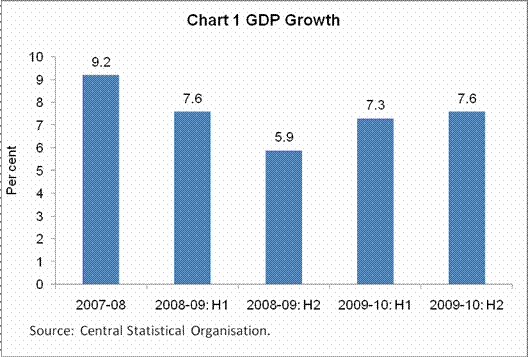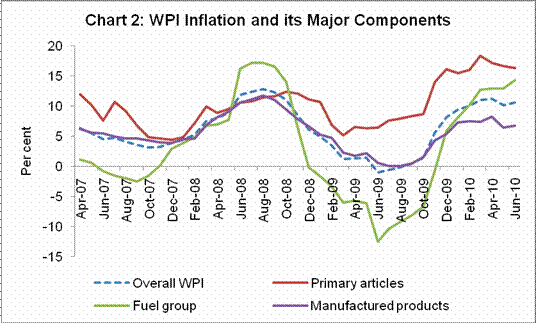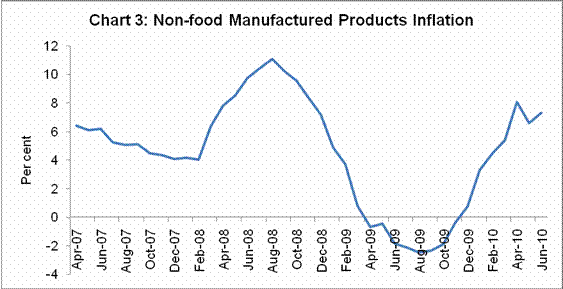Managing Inflation in the Post-Crisis Environment - આરબીઆઈ - Reserve Bank of India


Managing Inflation in the Post-Crisis Environment
Dr. Subir Gokarn, Deputy Governor, Reserve Bank of India
delivered-on ઑગસ્ટ 12, 2010
The Indian economy weathered the global crisis of 2008-09 quite well. Even as much of the developed world is still quite some distance from its pre-crisis growth rate, several emerging market economies (EMEs) have made up the lost ground relatively quickly. As indicated in Chart 1, India saw its growth rate decline from 9.2 per cent in 2007-08 to a trough of 6.7 per cent in 2008-09. There was a modest recovery in 2009-10 to 7.4 per cent, with the second half of the year showing a slight improvement over the first. The outlook for the current year is generally more positive, with several forecasters projecting growth to be around 8.5 per cent. While this is still somewhat short of the pre-crisis performance, there is a widespread perception that, with the several capacity constraints that the economy faces, more rapid growth than this would quickly trigger strong inflationary pressures.
Inflationary Pressures Regrettably, though, inflationary pressures have been visible in the economy even in the early stages of the recovery. Chart 2 indicates that the turnaround in headline inflation, as measured by the overall Wholesale Price Index (WPI) began in June 2009. This was clearly a period in which the recovery was in its very early stages, with the economy growing at an annual rate of around 7.5 per cent, significantly below the pre-crisis rate. It was logical to attribute the rise in the inflation rate to supply-side factors.
The validity of this inference is evident from the same chart. The prices of primary articles began to rise in March 2009 but the rate of increase accelerated sharply around August. A significant contributor to this was the rapid escalation in food prices as a consequence of a weak monsoon. Later in the year, as prospects of a global recovery looked brighter, commodity prices continued to rise. The combination of rising global commodity prices and domestic food prices contributed to a sustained increase in the inflation rate for primary articles until April 2010. There has been a plateauing since then. This is partly attributable to a global softening of commodity prices, as uncertainties about the sustainability of the recovery have arisen. If this continues, it will help to reverse the trend in this component of the index. But, the most significant cause of reversal is likely to be a moderation in food prices over the next few months in response to a reasonably good monsoon. The other supply-side driver of inflation in recent months has been energy. The inflation rate for the fuel component of the WPI began rising in June 2009. Though it remained in negative territory until October 2009, the rise itself contributed to a rise in the overall inflation rate. From October 2009 onwards, fuel inflation has been positive and rising quite rapidly. In short, the Indian economy has clearly seen a spurt of inflation, significantly driven by supply-side factors in a period during which growth was relatively slow. Prevailing wisdom on monetary policy suggests that supply-side pressures, particularly if they are temporary in nature, are not effectively tackled by conventional monetary measures, which are more directly aimed at reining in demand. Apart from the temporariness of these supply-side factors, the overall state of the economy should also be considered. The same wisdom argues that, if the economy is at or close to full capacity utilization, monetary actions in response to supply-driven inflationary pressures may be appropriate. While they will not directly address the cause of the inflation, by signaling a willingness to compress demand, they will rein in expectations of inflation spiraling out of control. The fact that the economy was still growing at a relatively slow pace in the second half of 2009-10 implied that there was some slack still available in capacities across sectors and that the threshold for strong monetary actions had not yet been reached. However, monetary assessments at that time could not be made independently of the very drastic measures that had been taken when the global crisis precipitated in September 2008. Those actions took the monetary position, as reflected in the repo and reverse repo rates and the cash reserve ratio (CRR) quite some distance from what would be considered normal levels. Even in the early stages of recovery, therefore, every opportunity to revert these instruments to normal needed to be exploited. I shall return to this point a little later in the article. The Rising Significance of Demand Coming back to the inflationary situation, while a significant proportion of the rise in the inflation rate over the past year can be attributed to supply-side factors, demand pressures became visible in early 2010. While it is difficult to identify a perfect measure of demand-side inflation - what is conventionally referred to as "core" inflation - a practical measure that reflects the underlying forces to an extent is the sub-component of the manufacturing component of the WPI, which excludes food products. Chart 3 displays the pattern of this sub-component "Non-food Manufacturing Inflation".
As growth slowed in 2008-09, this indicator also moved downwards. It actually went into negative territory for a few months, before turning marginally positive in December 2009. While this turnaround was clearly not indicative of any rapid build-up of demand pressures, the fact that it had happened was a signal that the business cycle had bottomed out and growth was on its way back up. However, after that rather sedate start, this indicator began to accelerate rather rapidly in the early months of 2010. At the time that this article was written, the numbers for June 2010 had just been released; this indicator had risen to 7.3 per cent. The inflation rates that the economy is now experiencing, both from the supply and the demand sides, are clearly a matter of great concern. It is incumbent on the government and the central bank to use all the means at their disposal to rein inflation in. In this effort, monetary policy has two specific objectives: (i) to prevent the spillover of supply-side pressures into a more broad-based inflationary process and (ii) to moderate demand to levels consistent with the capacity of the economy to meet it without provoking price increases. Monetary Policy: Thought and Action Let us look at the thinking and actions on the monetary front against the backdrop laid out above. As already indicated, drastic monetary actions were taken during the last quarter of 2008, sharply bringing down both the policy rates and the CRR. Looking back on this period, it can be reasonably argued that these measures contributed to the stabilization of the economy and the relatively small impact of the crisis by infusing massive amounts of liquidity into the system. The fiscal stimulus, which came in various forms during the same period, helped by directly creating demand in a situation in which private demand was sluggish. Without these combined interventions, the outcome would almost certainly have been far worse. The monetary stance remained in a critically supportive mode until October 2009, when the first steps to move towards a normal position were taken. Table 1 lists all the monetary actions taken from then until end-July 2010.
Four key concerns have influenced the sequence and magnitude of the monetary actions listed in the table. First, even while the Indian economy has recovered quite rapidly from the slowdown, there is persistent global uncertainty. EMEs have generally done quite well in coming out of the crisis, but a major part of the global economy - the US, the UK, the Euro zone - is not only showing only very modest signs of recovery, it is also manifesting new stresses, partly as a result of the huge build-up of sovereign debt, which governments used to support their various fiscal stimulus packages. Over the past few weeks, optimism about a sustained, even is slow, global recovery, has been giving ground to concerns about another imminent slowdown. One thing that we learnt from the events of 2008-09 was that India is not immune to global turbulence. Be it through trade, capital flows or a general sense of confidence about economic prospects, a global problem quickly becomes a domestic one. Given these linkages, the risks from the global economy need to be taken into consideration while formulating domestic policy. Second, the reality is that the policy instruments are far from being in a normal position. As the economy recovers, it is imperative that policy instruments be brought as quickly as possible back to a position consistent with the state of the economy. This is essential for the management of expectations as well as to re-create the capacity to respond, should another shock hit the economy. But, as important as it is to return to normal quickly, it is equally necessary to do so non-disruptively. The kind of rapid and massive reductions that were made to instruments during the crisis simply cannot be replicated in the reverse direction. Growth is picking up and confidence gradually returning to businesses and consumers, but given the vividness of the crisis, the process is still likely to be vulnerable to both external shocks and domestic ones. Rapid transitions in the policy regime might constitute one such shock. In essence, on this consideration, while rapid and drastic actions are entirely warranted when dealing with a crisis, managing a return to normalcy requires a more gradualist and calibrated approach. Third, notwithstanding the above two issues, the fact is that inflation has taken hold, with both supply and demand pressures contributing to it. Monetary policy must respond. The table indicates that it indeed has. Action on rates and liquidity, through the CRR, began in January and has continued at the measured pace indicated earlier over the past six months. One strong criticism of the Reserve Bank's approach has been that has been "too little, too late". I would submit that the test of this is yet to come. It is well-known that monetary policy acts with a lag. It could be anywhere between 6 and 12 months, even longer before demand side pressures abate in response to an action. Given this, actions taken during January-July 2010 should start to show their impact on inflation over the next 6 to 12 months. The fact that the non-food manufacturing inflation rate went up sharply during the first half of the year is in and of itself cannot be attributed to the absence of monetary actions during this year. To address that, actions would have had to be taken in the second half of 2009. But, at that point even the domestic recovery was at best in its early stages and its trajectory was quite uncertain. An anti-inflation stance in those conditions would have been rather risky. Finally, as I have already mentioned, an important lesson from the crisis was the critical role of liquidity in the financial system in maintaining economic stability. The policy approach over the past few months has been very conscious of the need to balance the exit from an abnormally high liquidity situation, which the response to the crisis created with the current liquidity requirements of both the public and private sectors. Conclusion To conclude, the management of current inflation requires both supply-side and demand-side approaches. Monetary policy has addressed the latter with a gradual, calibrated set of actions on both interest rates and liquidity management. The pace and sequencing of the actions has been influenced by both persistent global uncertainties and the need to support the domestic recovery. This has required a balancing act between reining in inflationary expectations and adequate liquidity in the domestic financial system. While the current rate of inflation is a legitimate concern, the results of this policy stance should become visible over the next few months. |
|||||||||||||||||||||||||||||||||||||||||||

























